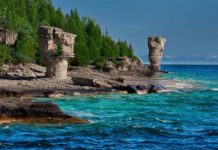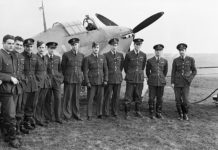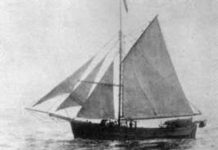
When the first white men came to North America, the north shore of Lake Erie was inhabited a people whose very name is still not determined. They were called the Attiwandaron by the Hurons, which means “those who speak a different dialect”. They were called the Neutrals by the French, who observed that they did not get involved in the major struggle between the Iroquois and the Hurons which was ongoing throughout the early years of French exploration in the region. Today, it is said that they called themselves either the Chonnonton (William C. Noble) or the Onguiaahra (Ron Brown). Given that confusion, I will refer to them as the Neutral Nation, as that is the name by which they are best known to history.
Location and Population
We are not sure when the Neutrals first established their nation, but they were probably there by the year 1000 AD. They occupied the land from the Detroit River to beyond the Niagara River into western New York state, as far north as Goderich in the west and Toronto in the east. In later years their settlements were concentrated between the Grand and Niagara Rivers. However, Neutral village sites have been excavated in London and at Clear Creek near Rondeau Provincial Park by Wilfred Jury in the first half of the twentieth century, and in Tillsonburg in the last decade.
By the time the Europeans arrived, the Neutrals lived in approximately 40 settlements, with about 12,000 inhabitants in total. It is not known how many there may have been prior to exposure to the European diseases which spread through the area in the 1630’s, but the standard rate of loss amongst the Aboriginal peoples was that 2 out of 3 died, so the original population could have been as high as 30,000 or more.
Women usually wore at least a skirt from waist to their knees. The men of the nation were extensively tattooed and often went naked in the hot summer weather. Lalemant commented that the people of the nation tended to be “taller, stronger, and better-proportioned” than the Huron.
They were not adept at canoeing; in their territory they did not have the birch trees to make really good canoes. Instead, they depended on a network of foot trails to get from one place to another.
Agriculture and Hunting
To 1300 AD the Glen Meyer culture prevailed, characterized by the cultivation of corn. By 1300 they were growing sunflowers so that they could use the oil. By 1400 they had added beans and squash to their farming, which would have been important sources of carbohydrates and protein. Their methods of farming exhausted the soil so that they had to relocate their villages every ten years or so. It was the men’s job to clear the land and the women’s job to tend the crops.
Hunting was extremely important to the Neutrals. The hardwood forests and mild climate supported a large quantity and variety of animals, and fresh meat was available year-round. They hunted deer, bear, squirrel, raccoon, wild turkey, wild cats, and the passenger pigeon. They would have practiced controlled periodic burning of the forest floor to keep the forests clear of underbrush and encourage growth that the deer especially could feed upon. This created the park-like woods that the first white explorers and settlers noticed, with mature Carolinian trees such as oaks and chestnut, and wildflowers carpeting the ground.
Trade
The Neutrals produced many important trade items which gave them considerable economic and strategic clout in pre-European America.
They cultivated tobacco, which they could trade with more northerly tribes which could not grow it for themselves, such as the Huron. Of course, tobacco played an important role in religious rituals for Aboriginal people, so that was a valuable trade item. In return, they got goods made with porcupine quills, as well as skins and furs.
They also traded animal hides with nations both to the north and the south. The Huron prized their black squirrel hides for making cloaks. They also traded white-tail deer hides with the Powhatan nation on Chesapeake Bay, receiving in return Snow Whelk shells which were used to make beads for wampum, the ceremonial belts which served instead of written documents as records of treaties or important events. The deer hide trade proved so profitable that the Neutral began to pen the deer to make it easier to kill them for their hides.
The Neutrals functioned as the weapons-dealers of the Eastern woodlands, because they possessed the flint quarries of what is now Point Abino near Fort Erie. Before the arrival of the Europeans with their iron blades and gunpowder and muskets, the flints served as tools and weapons. They could be made into knives or arrowheads, and the Neutral men became adept at knapping the flints into those items, which then could be traded with other nations without access to flints.
Finally, the Neutrals acted as middlemen in the north-south trade, conveying raccoon skins, wampum, shells and gourds to the Huron from nations further south.
Government
The Neutrals had a form of government which would have seemed more familiar to the incoming Europeans than many of the other Eastern Woodland nations. They were led by a war chief who had his own court, and the social structure had various ranks. Within their settlements they lived in fortified long houses. The individual towns may have been ruled in some cases by women, which would make sense given the matrilocal nature of the society; when a woman married, she brought her husband into her mother’s house, rather than moving into his father’s house.
Warfare
The French name for the nation, the Neutrals, was based solely on the fact that they were neutral in the ongoing conflicts between the Iroquois and the Hurons. They were not a peaceful people by any means. It was reported in 1641 by the Jesuit father Lalemant that they had four thousand warriors, and they engaged in ongoing warfare with many nations, including as the Atsistaehronons, or “Fire Nation” of lower Michigan.
They were also well-known for their ferocity towards their enemies. By 1300 they were sacrificing captured enemy warriors and practiced ritual cannibalism. They were even said by the Jesuits to burn captured women, which was not done by other nations. These practices continued well after 1500. In 1641, they and the Ottawa attacked a Mascouten town and took 800 women and children captive, taking them back to their nation to adopt or torture. 70 warriors were burnt at the stake, and old men were blinded and left to starve in the forests.
This was the Neutral nation at its most powerful, a warrior society with considerable economic and natural resources at its disposal, which was able to maintain a secure role as a neutral power between the Huron and Iroquois Confederacy. However, the changes to that balance of power wrought by the introduction of European weapons and fur trade would lead to the catastrophic end of the independent Neutral nation in the middle of the seventeenth century.
Sources:
- Lundy, Janice. “The End of the Neutral Nation and the Development of the Wyandot
- Brown, Ron. The Lake Erie Shore: Ontario’s Forgotten South Coast. Toronto: Dundurn Press, 2009.
- Hodge, Frederick Webb. Handbook of American Indians North of Mexico, Volumes 3-4. The Smithsonian Institution, Bureau of American Ethnology Handbook of American Indians. Reprint of 1912 edition.
- Noble, William C. “Neutral” The Canadian Encyclopedia. http://www.thecanadianencyclopedia.com/index.cfm?PgNm=TCE&Params=A1ARTA0005692
- Sultzman, Lee. “Neutrals History.” First Nations Histories. www.dickshovel.com/neutral.html
- Trigger, Bruce G. The children of Aataentsic: a history of the Huron People to 1660. Montreal: McGill-Queen’s Press,1987.
- Creighton University. “The Jesuit Relations.” http://puffin.creighton.edu/jesuit/relations/relations_21.html






